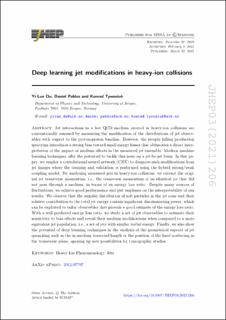| dc.contributor.author | Du, Yi-lun | |
| dc.contributor.author | Pablos Alfonso, Daniel | |
| dc.contributor.author | Tywoniuk, Konrad | |
| dc.date.accessioned | 2022-04-11T10:40:28Z | |
| dc.date.available | 2022-04-11T10:40:28Z | |
| dc.date.created | 2022-01-20T08:37:18Z | |
| dc.date.issued | 2021 | |
| dc.identifier.issn | 1126-6708 | |
| dc.identifier.uri | https://hdl.handle.net/11250/2990893 | |
| dc.description.abstract | Jet interactions in a hot QCD medium created in heavy-ion collisions are conventionally assessed by measuring the modification of the distributions of jet observables with respect to the proton-proton baseline. However, the steeply falling production spectrum introduces a strong bias toward small energy losses that obfuscates a direct interpretation of the impact of medium effects in the measured jet ensemble. Modern machine learning techniques offer the potential to tackle this issue on a jet-by-jet basis. In this paper, we employ a convolutional neural network (CNN) to diagnose such modifications from jet images where the training and validation is performed using the hybrid strong/weak coupling model. By analyzing measured jets in heavy-ion collisions, we extract the original jet transverse momentum, i.e., the transverse momentum of an identical jet that did not pass through a medium, in terms of an energy loss ratio. Despite many sources of fluctuations, we achieve good performance and put emphasis on the interpretability of our results. We observe that the angular distribution of soft particles in the jet cone and their relative contribution to the total jet energy contain significant discriminating power, which can be exploited to tailor observables that provide a good estimate of the energy loss ratio. With a well-predicted energy loss ratio, we study a set of jet observables to estimate their sensitivity to bias effects and reveal their medium modifications when compared to a more equivalent jet population, i.e., a set of jets with similar initial energy. Finally, we also show the potential of deep learning techniques in the analysis of the geometrical aspects of jet quenching such as the in-medium traversed length or the position of the hard scattering in the transverse plane, opening up new possibilities for tomographic studies. | en_US |
| dc.language.iso | eng | en_US |
| dc.publisher | Springer | en_US |
| dc.rights | Navngivelse 4.0 Internasjonal | * |
| dc.rights.uri | http://creativecommons.org/licenses/by/4.0/deed.no | * |
| dc.title | Deep learning jet modifications in heavy-ion collisions | en_US |
| dc.type | Journal article | en_US |
| dc.type | Peer reviewed | en_US |
| dc.description.version | publishedVersion | en_US |
| dc.rights.holder | Copyright 2021 The Author(s) | en_US |
| dc.source.articlenumber | 206 | en_US |
| cristin.ispublished | true | |
| cristin.fulltext | original | |
| cristin.qualitycode | 2 | |
| dc.identifier.doi | 10.1007/JHEP03(2021)206 | |
| dc.identifier.cristin | 1985604 | |
| dc.source.journal | Journal of High Energy Physics (JHEP) | en_US |
| dc.identifier.citation | Journal of High Energy Physics (JHEP). 2021, 2021, 206. | en_US |
| dc.source.volume | 2021 | en_US |
| dc.source.issue | 3 | en_US |

